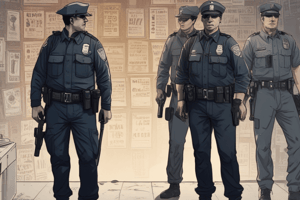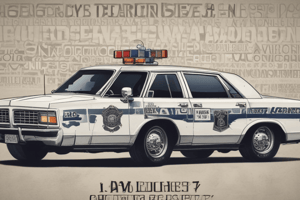Podcast
Questions and Answers
Which of the following best defines passive resistance?
Which of the following best defines passive resistance?
- A physical harm that involves some permanent incapacity
- A physical harm that carries a substantial risk of death
- A physical harm that involves some permanent disfigurement
- A nonviolent opposition to authority, especially a refusal to cooperate with legal requirements (correct)
Who is an immediate supervisor according to the text?
Who is an immediate supervisor according to the text?
- The supervisor who is acting in absence of the relief supervisor
- The supervisor who is regularly scheduled
- The supervisor who is filling in for the immediate supervisor
- The supervisor to whom Division Personnel is administratively accountable to within the chain of command (correct)
What is the definition of active resistance according to the text?
What is the definition of active resistance according to the text?
- Any physical harm that involves some permanent disfigurement
- Any physical harm that involves some permanent incapacity
- Any physical harm that involves acute pain of such duration as to result in substantial suffering or that involves any degree of prolonged or intractable pain (correct)
- Any physical harm that carries a substantial risk of death
According to the Division of Police, what are the Levels of Control used to control a suspect's actions?
According to the Division of Police, what are the Levels of Control used to control a suspect's actions?
What is the definition of Use of Force in the context of the Division of Police?
What is the definition of Use of Force in the context of the Division of Police?
What is the definition of Deadly Force according to the Division of Police?
What is the definition of Deadly Force according to the Division of Police?
Use of Force is only used to control aggressive behavior towards involved personnel
Use of Force is only used to control aggressive behavior towards involved personnel
Level 3 of Use of Force includes the use of impact weapons
Level 3 of Use of Force includes the use of impact weapons
Deadly Force is defined as any force that may result in serious injury
Deadly Force is defined as any force that may result in serious injury
Passive resistance involves physical harm that carries a substantial risk of death.
Passive resistance involves physical harm that carries a substantial risk of death.
Active resistance can involve physical harm that results in temporary, substantial incapacity.
Active resistance can involve physical harm that results in temporary, substantial incapacity.
The On Duty or Relief Supervisor is always the same person as the Immediate Supervisor.
The On Duty or Relief Supervisor is always the same person as the Immediate Supervisor.
According to the Division of Police, which of the following is NOT included in Level 2 of Use of Force?
According to the Division of Police, which of the following is NOT included in Level 2 of Use of Force?
Which of the following best defines Serious Injury according to O.R.C. 2901.01?
Which of the following best defines Serious Injury according to O.R.C. 2901.01?
What is the definition of Force according to the text?
What is the definition of Force according to the text?
What is the definition of physical harm in the context of Active Resistance?
What is the definition of physical harm in the context of Active Resistance?
What is the role of an On Duty or Relief Supervisor?
What is the role of an On Duty or Relief Supervisor?
What is the difference between Passive Resistance and Active Resistance?
What is the difference between Passive Resistance and Active Resistance?
Passive Resistance involves physical harm that carries a substantial risk of death
Passive Resistance involves physical harm that carries a substantial risk of death
Active Resistance can involve physical harm that results in temporary, substantial incapacity
Active Resistance can involve physical harm that results in temporary, substantial incapacity
The On Duty or Relief Supervisor is always the same person as the Immediate Supervisor
The On Duty or Relief Supervisor is always the same person as the Immediate Supervisor
True or false: Use of Force is only used to control resistive or aggressive behavior towards involved personnel?
True or false: Use of Force is only used to control resistive or aggressive behavior towards involved personnel?
True or false: Deadly Force is defined as any force that carries a substantial risk of death?
True or false: Deadly Force is defined as any force that carries a substantial risk of death?
True or false: Level 2 of Use of Force includes the use of impact weapons?
True or false: Level 2 of Use of Force includes the use of impact weapons?
Flashcards are hidden until you start studying




